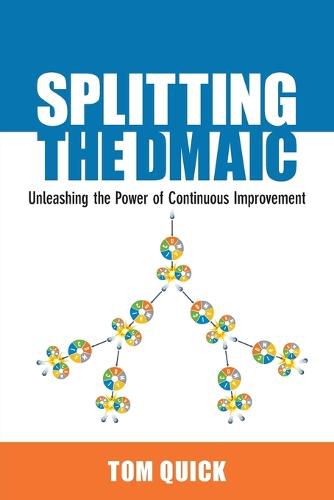Readings Newsletter
Become a Readings Member to make your shopping experience even easier.
Sign in or sign up for free!
You’re not far away from qualifying for FREE standard shipping within Australia
You’ve qualified for FREE standard shipping within Australia
The cart is loading…






This title is printed to order. This book may have been self-published. If so, we cannot guarantee the quality of the content. In the main most books will have gone through the editing process however some may not. We therefore suggest that you be aware of this before ordering this book. If in doubt check either the author or publisher’s details as we are unable to accept any returns unless they are faulty. Please contact us if you have any questions.
In 1917, we split the atom and released an incredible force for destruction. In 2019, we split the DMAIC and released an even bigger force for improvement. There is no doubt that the various improvement methods work. Whether it is PDCA or 7-Step problem-solving or A3 or IIs Not or DMAIC or any other tool, it has been used to great success in many organizations stretching back over decades. But why have some organizations been wildly successful with these and others not? The reason is that much of today's continuous improvement (CI) training is focused on tools. Training includes days or even weeks working through every possible tool a practitioner of CI might need. But rather than teach people about a set of tools that they might or might not use, why not teach them how to accomplish a specific objective? Why not give them a path for solving a particular type of problem that works most of the time? This way, anyone anywhere can make CI work by splitting the DMAIC. This book shows four typical paths through the DMAIC process to accomplish four different objectives: Reduce variability of a characteristic Reduce failures of a machine Reduce waste in a process Reduce the frequency of a defect For each path, the following is presented: -an overview of the purpose and actual steps through the DMAIC process for that path. -Step Details-a detailed description of each step including specific tools used. -Checklist-a simple one-page sheet that anyone can use as a guide along the path. Think of these as a new app called DMAIC Maps, which helps people get around the DMAIC world the same way Google Maps helps in the real world. Project selection and team management are also discussed, since the choice of projects is crucial to creating context and therefore success.
$9.00 standard shipping within Australia
FREE standard shipping within Australia for orders over $100.00
Express & International shipping calculated at checkout
This title is printed to order. This book may have been self-published. If so, we cannot guarantee the quality of the content. In the main most books will have gone through the editing process however some may not. We therefore suggest that you be aware of this before ordering this book. If in doubt check either the author or publisher’s details as we are unable to accept any returns unless they are faulty. Please contact us if you have any questions.
In 1917, we split the atom and released an incredible force for destruction. In 2019, we split the DMAIC and released an even bigger force for improvement. There is no doubt that the various improvement methods work. Whether it is PDCA or 7-Step problem-solving or A3 or IIs Not or DMAIC or any other tool, it has been used to great success in many organizations stretching back over decades. But why have some organizations been wildly successful with these and others not? The reason is that much of today's continuous improvement (CI) training is focused on tools. Training includes days or even weeks working through every possible tool a practitioner of CI might need. But rather than teach people about a set of tools that they might or might not use, why not teach them how to accomplish a specific objective? Why not give them a path for solving a particular type of problem that works most of the time? This way, anyone anywhere can make CI work by splitting the DMAIC. This book shows four typical paths through the DMAIC process to accomplish four different objectives: Reduce variability of a characteristic Reduce failures of a machine Reduce waste in a process Reduce the frequency of a defect For each path, the following is presented: -an overview of the purpose and actual steps through the DMAIC process for that path. -Step Details-a detailed description of each step including specific tools used. -Checklist-a simple one-page sheet that anyone can use as a guide along the path. Think of these as a new app called DMAIC Maps, which helps people get around the DMAIC world the same way Google Maps helps in the real world. Project selection and team management are also discussed, since the choice of projects is crucial to creating context and therefore success.